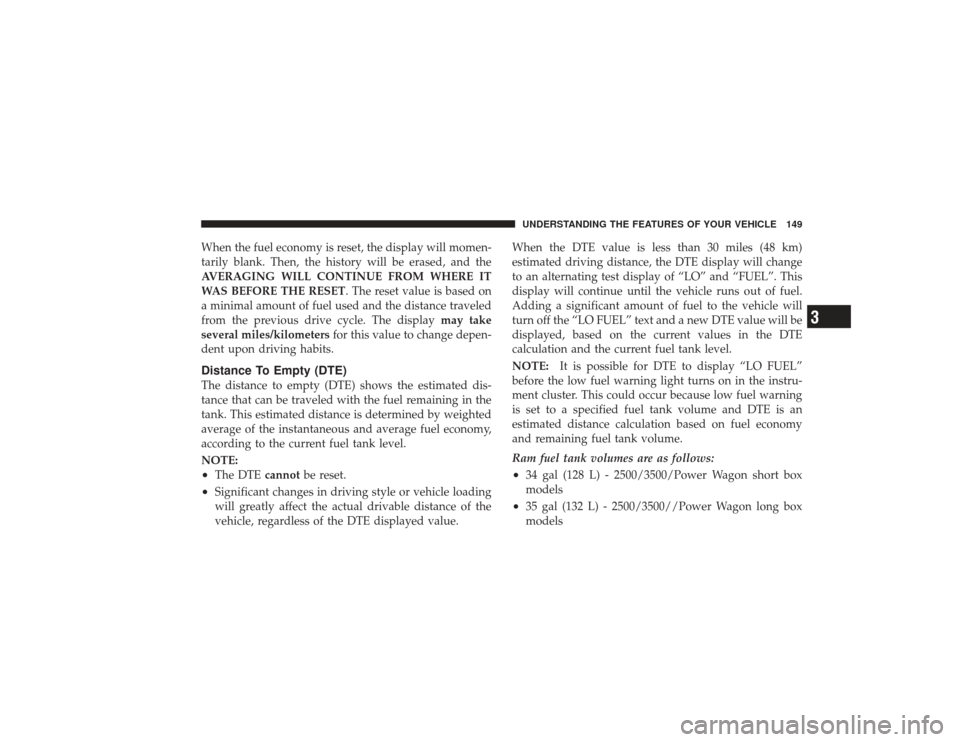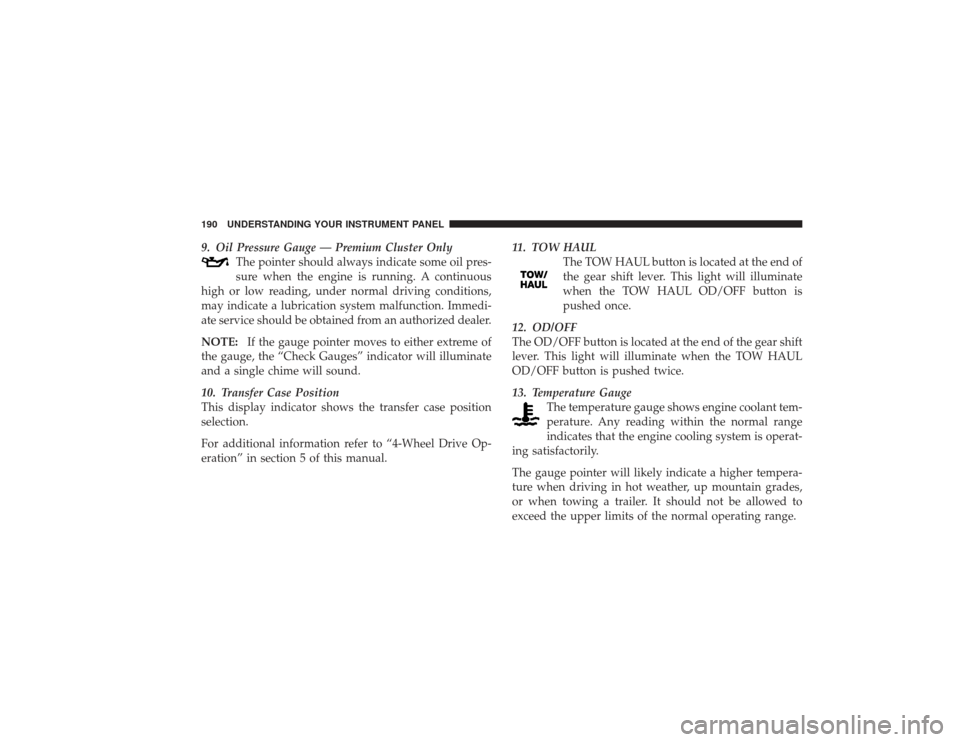Page 151 of 532

When the fuel economy is reset, the display will momen-
tarily blank. Then, the history will be erased, and the
AVERAGING WILL CONTINUE FROM WHERE IT
WAS BEFORE THE RESET. The reset value is based on
a minimal amount of fuel used and the distance traveled
from the previous drive cycle. The displaymay take
several miles/kilometers for this value to change depen-
dent upon driving habits.Distance To Empty (DTE)The distance to empty (DTE) shows the estimated dis-
tance that can be traveled with the fuel remaining in the
tank. This estimated distance is determined by weighted
average of the instantaneous and average fuel economy,
according to the current fuel tank level.
NOTE:•
The DTE cannotbe reset.
•
Significant changes in driving style or vehicle loading
will greatly affect the actual drivable distance of the
vehicle, regardless of the DTE displayed value. When the DTE value is less than 30 miles (48 km)
estimated driving distance, the DTE display will change
to an alternating test display of “LO” and “FUEL”. This
display will continue until the vehicle runs out of fuel.
Adding a significant amount of fuel to the vehicle will
turn off the “LO FUEL” text and a new DTE value will be
displayed, based on the current values in the DTE
calculation and the current fuel tank level.
NOTE:
It is possible for DTE to display “LO FUEL”
before the low fuel warning light turns on in the instru-
ment cluster. This could occur because low fuel warning
is set to a specified fuel tank volume and DTE is an
estimated distance calculation based on fuel economy
and remaining fuel tank volume.
Ram fuel tank volumes are as follows:
•
34 gal (128 L) - 2500/3500/Power Wagon short box
models
•
35 gal (132 L) - 2500/3500//Power Wagon long box
modelsUNDERSTANDING THE FEATURES OF YOUR VEHICLE 149
3
Page 152 of 532
Trip Odometer (ODO)NOTE:The maximum value is approximately
6000 miles (9956 km). Then the trip odometer must be
reset in order to update the trip odometer miles/
kilometers.
This display shows the distance traveled since the last
reset. Resetting of this screen will cause the trip odometer
to change to zero.Elapsed Time (ET)This display shows the accumulated ignition ON time
since the last reset. Resetting the Elapsed Time will cause
the display to change to zero.
C/T ButtonUse this button to select a readout of the outside tem-
perature and one of eight compass headings that indicate
the direction in which the vehicle is facing.
C/T Button
150 UNDERSTANDING THE FEATURES OF YOUR VEHICLE
Page 153 of 532

WARNING!
Even if the display still reads a few degrees above
32°F ( 0°C), the road surface may be icy, particularly
in woods or on bridges. Drive carefully under such
conditions to prevent an accident and possible per-
sonal injury or property damage.Automatic Compass CalibrationThis compass is self-calibrating which eliminates the
need to manually set the compass. When the vehicle is
new, the compass may appear erratic and the CAL
symbol will be displayed.
After completing up to three 360 degree turns, with the
vehicle traveling less than 5 mph (8 km/h), in an area free
from large metal or metallic objects, the CAL symbol will
turn off and the compass will function normally.
Manual Compass CalibrationNOTE:To ensure proper compass calibration, make
sure the compass variance is properly set before manu-
ally calibrating the compass.
If the compass appears erratic and the CAL symbol does
not appear, you must manually put the compass into the
“Calibration” mode.Recalibrating The CompassStart the engine and leave the transmission in the PARK
position then set the display to “Compass/Temperature.”
Press and hold the RESET button to change the display
between VAR (compass variance) and CAL (compass
calibration) modes. When the CAL symbol is displayed,
complete one 360 degree turn in an area free from large
metal objects or power lines. The CAL symbol will turn
off and the compass will function normally.UNDERSTANDING THE FEATURES OF YOUR VEHICLE 151
3
Page 154 of 532
NOTE:Magnetic materials should be kept away from
the overhead console. This is where the compass sensor is
located.
Compass Variance is the difference between magnetic
North and geographic North. In some areas of the
country, the difference between magnetic and geographic North is great enough to cause the compass to give false
readings. If this occurs, the compass variance must be set
according to the Compass Variance Map.
NOTE:
The default for the compass variance is Zone 8.
To set the variance: Turn the ignition ON and set the
display to “Compass/Temperature.” Press and hold the
RESET Button
Compass Variance Map
152 UNDERSTANDING THE FEATURES OF YOUR VEHICLE
Page 155 of 532

RESET button approximately five seconds. The last vari-
ance zone number will be displayed. Press the STEP
button to select the new variance zone and press the
RESET button to resume normal operation.Outside TemperatureBecause the ambient temperature sensor is located under
the hood, engine temperature can influence the displayed
temperature, therefore, temperature readings are slowly
updated when the vehicle speed is below 20 mph
(30 km/h) or during stop and go driving.GARAGE DOOR OPENER — IF EQUIPPEDHomeLink�replaces up to three remote controls (hand-
held transmitters) that operate devices such as garage
door openers, motorized gates, lighting, or home security
systems. The HomeLink� unit operates off of your vehi-
cle’s battery. The HomeLink�
buttons are located in the overhead
console, and contain one, two, or three dots/lines desig-
nating the different HomeLink� channels.
NOTE: HomeLink� is disabled when the Vehicle Theft
Alarm is active.
HomeLink Buttons
UNDERSTANDING THE FEATURES OF YOUR VEHICLE 153
3
Page 157 of 532

Your vehicle should be parked outside of the garage
while training.
1. Turn the ignition switch to the ON/RUN position.
2. Place the hand-held transmitter 1 to 3 inches (3 to
8 cm) from the HomeLink�buttons while keeping the
HomeLink� display in view.
For optimal training, point the battery end of the hand-
held transmitter away from the HomeLink�.
3. Simultaneously, press and hold both the chosen
HomeLink�button and the hand-held transmitter button
until the indicator(s) change from a slow to a rapid flash
rate.
Then release both the HomeLink� and hand-held trans-
mitter buttons.
It may take up to 30 seconds or longer in rare cases. The
garage door may open and close while you train. If the signal is too weak to train, replace the battery in the
original hand-held transmitter.
NOTE:
Some gate operators and garage door openers
may require you to replace Step #3 with procedures
noted in the “Gate Operator/Canadian Programming”
section.
4. Press and hold the just-trained HomeLink� button. If
the indicator(s) blink rapidly for two seconds and then
remains constant, continue with the next section: “Pro-
gramming A Rolling Code System”.
NOTE: After training a HomeLink� channel, if the
garage door does not operate with HomeLink� and the
garage door opener was manufactured after 1995, the
garage door opener may have rolling code. If so, proceed
to the heading, “Programming A Rolling Code System.”
UNDERSTANDING THE FEATURES OF YOUR VEHICLE 155
3
Page 192 of 532

9. Oil Pressure Gauge — Premium Cluster OnlyThe pointer should always indicate some oil pres-
sure when the engine is running. A continuous
high or low reading, under normal driving conditions,
may indicate a lubrication system malfunction. Immedi-
ate service should be obtained from an authorized dealer.
NOTE: If the gauge pointer moves to either extreme of
the gauge, the “Check Gauges” indicator will illuminate
and a single chime will sound.
10. Transfer Case Position
This display indicator shows the transfer case position
selection.
For additional information refer to “4-Wheel Drive Op-
eration” in section 5 of this manual. 11. TOW HAUL
The TOW HAUL button is located at the end of
the gear shift lever. This light will illuminate
when the TOW HAUL OD/OFF button is
pushed once.
12. OD/OFF
The OD/OFF button is located at the end of the gear shift
lever. This light will illuminate when the TOW HAUL
OD/OFF button is pushed twice.
13. Temperature Gauge The temperature gauge shows engine coolant tem-
perature. Any reading within the normal range
indicates that the engine cooling system is operat-
ing satisfactorily.
The gauge pointer will likely indicate a higher tempera-
ture when driving in hot weather, up mountain grades,
or when towing a trailer. It should not be allowed to
exceed the upper limits of the normal operating range.190 UNDERSTANDING YOUR INSTRUMENT PANEL
Page 194 of 532

15. Shift Lever Indicator (Automatic Transmission
Only)
This display indicator shows the automatic transmission
shift lever selection.
NOTE:You must apply the brakes before shifting from
PARK.
16. Odometer/Trip Odometer
The odometer shows the total distance the vehicle has
been driven. U.S. federal regulations require that upon
transfer of vehicle ownership, the seller certify to the
purchaser the correct mileage that the vehicle has been
driven. Therefore, if the odometer reading is changed
during repair or replacement, be sure to keep a record of
the reading before and after the service so that the correct
mileage can be determined.
The two trip odometers show individual trip mileage. To
switch from odometer to trip odometers, press and
release the Trip Odometer button. To reset a trip odometer, display the desired trip odom-
eter to be reset then push and hold the button until the
display resets (approximately two seconds).
Vehicle Warning Messages
When the appropriate conditions exist, messages such as
“door” (indicates that a door(s) may be ajar), “hood” (if
the hood is open or ajar, on vehicles with remote start),
“gASCAP” (indicates that your gas cap is possibly loose
or damaged), “LoW tirE” (indicates low tire pressure),
CHANgE OIL” (indicates that the engine oil should be
change), “LoWASH” (low washer fluid), “ESPOFF” (in-
dicates that ESP is turned off), and “noFUSE” (indicates
that the IOD fuse is removed from the Integrated Power
Module), will display in the odometer.
NOTE:
There is also an engine hour function. This
indicates the total number of hours the engine has been
running. To display the engine hours perform the follow-
ing: Place the ignition in RUN, but do not start the192 UNDERSTANDING YOUR INSTRUMENT PANEL